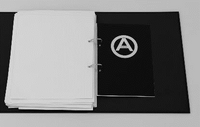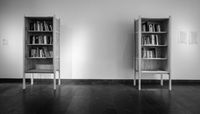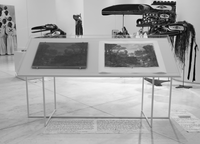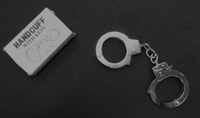Between 1975 and 1979, the North-American artist Christopher D’Arcangelo (1955–1979) developed an artistic practice remarkable for its radicality and critical import concerning the role of the artist, the status of the art object, and the institutionalization of art.1 He was primarily motivated by a desire for a radical democratization of the production and reception of art. Access to the written and visual material he compiled over a five-year period to document his work, before his untimely death at age twenty-four in 1979, is limited to consultation at New York University’s Fales Library & Special Collections,2 which acquired his papers for its “Downtown Collection” from the artist’s estate in 2009.3 D’Arcangelo’s work is thus protected from the art market and its circulation is subsequently restricted: as stipulated, only those documents that the artist initially intended for public circulation can be shown outside the collection. In this way, his political commitment to a shared, common culture independent of art-market speculation is respected. An exception was made for a facsimile of one of the binders he assembled to present his work when it was included in an exhibition at the National Museum of Contemporary Art, Athens (EMST), as part of documenta 14.4 On the ground floor of the museum, housed in a renovated brewery, a series of works, including D’Arcangelo’s binder, questioned the status of contemporary art practice in a new (neoliberal) logic of capitalist circulation, not least of all from the vantage point of the museum itself, which, due to economic recession, had for several years been unable to open its own collection to the public, nor officially open the building in its entirety.
A copperplate engraving by Étienne Baudet, Landscape with Diogenes, after a painting by Nicolas Poussin, was also included.5 In viewing the engraving, visitors found themselves on the very spot where Poussin had imagined ancient Greece while making his painting in Rome — in other words, exactly where the EMST museum is currently located, not far from the Acropolis along the Ilissos River, which today runs concealed underground. Inhabiting Poussin’s dream world, visitors to documenta 14 were thus confronted with the figure of Diogenes as he encounters a young boy drinking water out of the palm of his hand from the Ilissos, now hidden directly beneath the museum’s floor. Before this seemingly insignificant act, the cynical philosopher, in a gesture of willful renunciation, throws away the cup he carries in his pouch. In contrast, diagonally opposite the figures depicted in the foreground, the top of the Acropolis rises in the background. It was here that Poussin painted the Belvedere of Rome in place of the Parthenon.
The Belvedere, of course, houses the first modern collection of classical antiquities, stripped of their former spiritual value. The collection was created by Pope Julius II in the early sixteenth century as a means of amassing cultural capital. To oppose capital requires force, strength, courage, an active poverty, and dematerialized resistance. The decision during documenta 14 to exhibit the collection of Greece’s National Museum of Contemporary Art at the Fridericianum in Kassel, and to open the former, in Athens, with an inaugural exhibition of current international art, enlarged, in a curatorial gesture, the strategy of other works exhibited on the museum’s ground floor, including Sammy Baloji’s Tales of the Copper Cross Garden: Episode I (2017), Beau Dick’s John Livingston Penny Copper (2012), Bia Davou’s Circuit (1975), Chryssa’s Bigger Dividends (1960), and Dan Peterman’s Athens Ingot Project (Copper) (2017).
D’Arcangelo’s unauthorized actions at major museums in the mid-to-late 1970s clearly inspired this spatial shift between the Greek and German museums in questioning the future role of the museum as a public institution. In the case of the Greek museum, on the one hand, this meant focusing on innovative practices open to the outside world rather than being confined to a national collection; and, in the case of the Kunsthalle Fridericianum, on the other, it meant relinquishing the Kunsthalle’s dominant role as documenta’s central exhibition site, in order to establish a more horizontal, historical, and contextual relation to the other sites and the exhibition as a whole.
Through his actions, D’Arcangelo engaged his body, its surface serving as a space of inscription to convey his work.6 He described the places where he undertook his actions, and which he considered an integral component of his work, as “criteria spaces.”7 He thus approached them as apparatuses, in the sense that Michel Foucault gives to the term: “discourses, institutions, architectural arrangements, regulations, laws, administrative measures, scientific statements, philosophical propositions, morality, and philanthropy, etc.”8 As the philosopher Giorgio Agamben notes, apparatuses thus have “the capacity to capture, orient, determine, intercept, model, control, or secure the gestures, behaviors, opinions, or discourses of living beings.”9 For Agamben, the museum occupies the same space and function once reserved for the temple as a place of sacrifice.10 It is the place where things are removed from common use and transferred to a separate sphere. Sacrifice is the apparatus that performs and regulates the separation and passage from the profane to the sacred. What is separated by ritual can, in the same instance, be restored to the profane world. According to Agamben, “Profanation is the counter-apparatus that restores to common use what sacrifice had separated and divided.”11
The unauthorized actions that D’Arcangelo directed at public and private art institutions reversed the process of sacralization via an act of profanation. For example, a document from the artist’s archives details his illicit action at the Guggenheim Museum on May 3, 1975, as follows:
When Chris came in the Guggenheim lobby he looked around, walked toward the center of the floor and put his jacket down. He took off his shirt, sat down, and then took off his boots and handcuffed his ankles together. A woman guard came over and tried to understand what the hell was going on. By the time she realized Chris wasn’t moving, he had handcuffed his wrists together behind him and turned over to lay on his stomach with his back exposed. On his back was stenciled: WHEN I STATE THAT I AM AN ANARCHIST I MUST ALSO STATE THAT I AM NOT AN ANARCHIST TO BE IN KEEPING WITH THE (…) IDEA OF ANARCHISM. LONG LIVE ANARCHISM. She called other guards who came to stand around […] Lying still in the center of the circular building, Chris began to look to me like any other piece of art hanging or sitting on the floors […] The only difference being he was alive and therefore treated differently. The cops came and grabbed Chris by the handcuffs on his wrists and pulled him off the floor to his feet […] The way the museum is designed it looked like a coliseum, with people encircling the action from the ground floor as well as the floors above. Chris put on his boots and was escorted outside by the cops.”12
The guards’ forcible removal of the artist’s body during his action at the Guggenheim Museum in 1975 reveals the coercive nature of the institution’s “sacred” criteria of selection. In reversing the creative process through his profane performance, D’Arcangelo outwitted the museum’s mission of exhibiting art objects by exposing it as a process by which the artist’s practice is essentially rendered invisible.
In his Open Museum Proposal from the same year, which he produced in the form of a flyer and handed out to visitors while chained by the ankle to a bench in the lobby of the Metropolitan Museum of Art on July 23, 1975, D’Arcangelo proposed that the museum “open its doors for seven consecutive days to anyone wishing to place an object or perform any activity in the museum.”13 During his first and only invitation to take part in a group exhibition in a private gallery, he submitted a proposal for an “Open Store” — and hence, an “Open Market” — in which the gallery’s exhibition space not used by the other exhibiting artists would be made available to anyone wishing to exhibit and sell an object of their choice.14 For an unrealized project at the Van Abbemuseum in Eindhoven, D’Arcangelo proposed to divide the museum into two distinct spaces: the first would display the museum’s entire collection, while the second would contain objects and activities chosen by the city’s inhabitants.15 During an illicit action at the Louvre in 1978, he removed a painting by Thomas Gainsborough from where it was hanging in the permanent collection and, resting it on the floor with its back to the wall, replaced it with a written statement that read: “When you look at a painting, where do you look at that painting? What is the difference between painting and painting on the floor?”16 Invited to contribute to the January 1977 issue of the LAICA Journal, D’Arcangelo responded to what he called the museum’s “curatorial control” by proposing an empty double-page spread, which readers could freely use and exhibit when and where they chose in the institute’s exhibition space so long as the institute remained open to the public.17 Among his notes at the time, D’Arcangelo stated: “If I am invited again to work inside the system, I will request that for the time of my exhibition the gallery or museum will close. Not just close to the public but cease to function, to plan future exhibitions, make financial transactions. No lights or heat will be used and none of the employees shall work.”18
D’Arcangelo’s note recalls similar projects, such as Robert Barry’s Closed Gallery (1969); Michael Asher’s intervention at the Claire Copley Gallery in Los Angeles (1974); Mladen Stilinovic´’s Artist at Work (1978); Felix Gonzalez-Torres’s The Beach is Nice, performed in Puerto Rico (1983); Swetlana Heger and Plamen Dejanov’s On Holiday at the Air de Paris Gallery in Paris (1998); Santiago Sierra’s Space Closed by Corrugated Metal at the Lisson Gallery in London (2002); or, more recently, also in London at the Chisenhale Gallery, Maria Eichhorn’s 5 weeks, 25 days,175 hours (2016). These works are indebted to Erik Satie and Francis Picabia’s ballet Relâche, which premiered at the Théâtre des champs Élysées in 1924. In each case they employ the same concept: artistic practice, along with its discursive framework and mode of subjectivation, is rendered both manifest and invisible (relâche, in French, means a break or a day off ) in that they stage a production that is experienced as an absence. This is underscored, for example, in the title of a work, Production, by Annie Vigier and Franck Apertet (les gens d‘Uterpan) commissioned by the Franche-Comté Regional Contemporary Art Fund in Besançon, France, in which two dates, or temporal markers, replaced the two choreographers’ physical presence.19 During the dates mentioned, they left their home and workplace to engage in an anonymous activity in an undisclosed location and maintained no contact with their dance company. A similar strategy of withdrawal also characterized another work by Vigier and Apertet, Library,20 shown at documenta 14 in Kassel, in the entrance to the Torwache building on the city‘s main street. Two sets of bookshelves in the building’s lobby contained a selection of essays and reference books on contemporary dance and performance. Chosen on the sole basis that they include no reference to the choreographers’ work or les Gens d’Uterpan dance company, the selection underscored the irreducible gap between the physical movement of a performance, which adheres to an indivisible duration, and the infinitely divisible analysis of a performance as a recorded event, to which the books in the selection attest. Furthermore, the choreographers raised the following questions posed by Didier Eribon in L’insoumission en héritage, the title of a collection of essays on the legacy of the French sociologist Pierre Bourdieu: “Who speaks? Who can speak? Who does not speak when others speak? But also what would those who do not speak say if they were allowed to speak?”21 To a certain extent, Vigier and Apertet revealed documenta 14 as a validating authority, to which they contributed and for which they subsequently received recognition, in order to demonstrate the discriminatory mechanism it represents for those who it excludes and who they would join once the event was over.
-
See “Anarchism without Adjectives: On the Work of Christopher D’Arcangelo 1975–1979,” co-curated by Dean Inkster and Sébastien Pluot in collaboration with Pierre Bal-Blanc at the CAC Brétigny, Brétigny-sur-Orge, France (July–August 2011). ↩
-
Guide to the Christopher D’Arcangelo Papers 1965–2003 (bulk 1975–1978): http://dlib.nyu.edu/findingaids/html/fales/darcangelo/ ↩
-
The artist’s archive was donated to the Fales Library and Special Collections, New York University, by Cathy Weiner and the D’Arcangelo Family Partnership. ↩
-
Archival material (1965–79) from the Christopher D’Arcangelo Papers, Fales Library and Special Collections, New York University, was shown (courtesy of Cathy Weiner and the D’Arcangelo Family Partnership) at the National Museum of Contemporary Art (EMST), Athens, documenta 14, Athens-Kassel in 2017: https://www.documenta14.de/en/artists/16177/christopher-d-arcangelo. ↩
-
Étienne Baudet, “Paysage avec Diogène” after Nicolas Poussin, (1701), copperplate etching (58 × 76 cm), Musée du Louvre, Département des arts graphiques, Paris. ↩
-
For several of his elicit actions, D’Arcangelo stenciled the following statement on his back: “WHEN I STATE THAT I AM AN ANARCHIST I MUST ALSO STATE THAT I AM NOT AN ANARCHIST TO BE IN KEEPING WITH THE (…) IDEA OF ANARCHISM. LONG LIVE ANARCHISM.” ↩
-
“The museum functions as a ‘criteria space,’ it determines the value of objects and activities in our daily lives.” See “The Open Museum Proposal” (July 23, 1975) in the Christopher D’Arcangelo Papers 1965–2003 (bulk 1975–1978), Fales Library and Special Collections, New York University. ↩
-
Michel Foucault in Colin Gordon ed., Power/Knowledge: Selected Interviews and Other Writings by Michel Foucault, 1972–1977 (New York: Pantheon Books, 1980), 194. ↩
-
Giorgio Agamben, What Is an Apparatus? and Other Essays (Meridian: Crossing Aesthetics), trans. David Kishik and Stefan Pedatella (Stanford, CA.: Stanford University Press, 2009), 14. ↩
-
Giorgio Agamben, Profantations, trans. J. Fort (New York: Zone Books, 1999), 84. ↩
-
Agamben, What is an Apparatus?, 19. ↩
-
Guggenheim Action, May 3, 1975, Christopher D’Arcangelo Papers 1965–2003 (bulk 1975–1978), Fales Library and Special Collections, New York University. ↩
-
“The Open Museum Proposal, July 23, 1975,” Christopher D’Arcangelo Papers 1965–2003 (bulk 1975–1978), Fales Library and Special Collections, New York University. ↩
-
The Rosa Esman Gallery rejected the proposal following complaints from the other invited artists, who threatened to withdraw from the exhibition if D’Arcangelo’s proposal went ahead. D’Arcangelo was subsequently excluded from the exhibition. He, however, staged an illicit action in the gallery during the exhibition opening. See “Rosa Esman Gallery, June 20, 1978,” Christopher D’Arcangelo Papers 1965–2003 (bulk 1975–1978), Fales Library and Special Collections, New York University. ↩
-
“The Van Abbemusuem Project, Eindhoven, 1976–1979,” Christopher D’Arcangelo Papers, 1965–2003 (Bulk 1975–1978). ↩
-
“Louvre Action, March 9, 1978,” Christopher D’Arcangelo Papers 1965–2003 (bulk 1975–1978), Fales Library and Special Collections, New York University. ↩
-
Christopher D’Arcangelo, “LAICA as an Alternative to Museums,” LAICA Journal 13 (January, 1977), 31–34. ↩
-
Loose-leaf notes, Christopher D’Arcangelo Papers 1965–2003 (bulk 1975–1978), Fales Library and Special Collections, New York University. ↩
-
The duration of the piece is determined by the funds allocated to its production. The amount, divided into two equal parts, is converted into daily allowance indexed to the artists’ monthly income during the previous year. ↩
-
Bibliothèque (2017–); bookcase design: Dominique Mathieu; research in France (2017): Florian Gaité; research in Germany (2017): Verena Kittel. The complete bibliography is available at http://www.lesgensduterpan.com/projbibliothequeuk.html. ↩
-
Edouard Louis, ed., Pierre Bourdieu: L’insoumission en héritage (Paris: PUF, 2013). ↩
Pierre Bal-Blanc (born 1965) is an independent curator and author based in Athens and Paris. His work focuses on two main themes: reflection on institutional practice frameworks or their deconstruction, and the history of performance in a broader sense, which is a starting point for a new, distinctly authorial interpretation and activation of the legacy of artists working on the periphery of the Western canon. Between 2003–2014, Bal-Blanc was director of the CAC Brétigny in the suburb of Paris. He was also one of the curators of documenta 14 in Athens and Kassel under the artistic direction of Adam Szymczyk, and a guest curator of the 7th Lyon Biennale under the direction of Hans Ulrich Obrist and Stephanie Moisdon. In 2021, he made the Collective Exhibition for a Single Body – The Private Score for Galerias Municipais in Lisbon, focusing on artists from Central and South-Eastern Europe. In 2017, Sternberg Press published the book Project Phalanstère summarizing Bal-Blanc’s experiments at the CAC Brétigny.
- Language
- Type
- Palate Cleanser2025
- cs
- en
text- 2,000 words
- Monika Pascoe Mikyšková: Memories that aren’t mine2025
- cs
- en
text- 500 words
- Kino Kosmos under the Cosmic Sun2025
- cs
- en
text- 9,800 words
- Kino Kosmos2025
- cs
- en
text- 3,700 words
- Dorota Jurczak: Pyk, Sciak etc.2025
- cs
- en
text- 1,500 words
- Sprouts2025
- cs
- en
text- 800 words
- Curatorial text for the exhibition by Petr Bosák, Robert Jansa and Adam Macháček2025
- cs
- en
text- 900 words
- Curatorial text for Martin Zetová's exhibition2025
- cs
- en
text- 1,100 words
- Cello & Piano2025
- cs
- en
audio - Primeval Forest, Garden and Wall2024
- cs
- en
- pl
text- 1,100 words
- Interview with Barbora Lungová2024
- cs
audio - Barbora Lungová and the gift of painting2024
- cs
- en
text- 1,400 words
- Julie in the Worlds of Fantasy. Marginalia.2024
- cs
- en
text- 1,600 words
- Pigeon newspaper2024text
- Workbook for children The Shell No. 32024
- cs
- en
text- 200 words
- Zvířecí kustodi – Bee2024
- cs
- en
video- 32’32”
- Animal Custodians – Rabbit2024
- cs
- en
video- 33’18”
- Animal Custodians – Owl2024
- cs
- en
video- 28’05”
- Animal Custodians – Fox2024
- cs
- en
video- 32’05”
- Animal Custodians – Deer2024
- cs
- en
video- 33’45”
- Animal Custodians – Pigeon2023
- cs
- en
video- 32’20”
- Animal Custodians – Raven2023
- cs
- en
video- 21’24”
- If you have a canary with a poor singing voice, it will never stop singing after this training video!2023
- cs
- en
video- 21’24”
- Checking the Stove2023
- cs
- en
video- 5’34”
- 0’40”
- Trust2023
- cs
- en
video- 7’03”
- Is it the flight or the fall what my friend is falling for?2023
- cs
- en
video- 12’08”
- Animal News2023
- cs
- en
text- 1,500 words
- Dan Walwin: Relief2023
- cs
- en
text- 1,000 words
- Ukrainian Culture at the Time of Russian Aggression2023
- cs
- en
text- 100 words
- Freely Accessible Books on the Topic of Ukrainian Culture at the Time of Russian Aggression2023
- cs
- en
text- 500 words
- They Thought We Were Alive and They Run Screaming2023
- cs
- en
text- 1,200 words
- On Renewed Land: Locating Ukrainian Destiny2023
- cs
- en
text- 1,900 words
- I Can Hear the Grass Grow2023
- cs
- en
text- 600 words
- Interview related to the exhibition Optimised Fables about a Good Life2022
- cs
- en
text- 900 words
- Interview related to the exhibition Optimised Fables about a Good Life2022
- cs
- en
text- 900 words
- Interview related to the exhibition Optimised Fables about a Good Life2022
- cs
- en
text- 700 words
- Interview related to the exhibition Optimised Fables about a Good Life2022
- cs
- en
text- 1,700 words
- Interview related to the exhibition Optimised Fables about a Good Life2022
- cs
- en
text- 1,000 words
- Interview related to the exhibition Optimised Fables about a Good Life2022
- cs
- en
text- 1,100 words
- Interview related to the exhibition Optimised Fables about a Good Life2022
- cs
- en
text- 900 words
- Interview related to the exhibition Optimised Fables about a Good Life2022
- cs
- en
text- 1,600 words
- Interview related to the exhibition Optimised Fables about a Good Life2022
- cs
- en
text- 900 words
- Interview related to the exhibition Optimised Fables about a Good Life2022
- cs
- en
text- 1,400 words
- The Night2022
- cs
text- 0 words
- Optimised Fables about a Good Life2022
- cs
- en
text- 800 words
- In the footsteps of the Greek underground II: Longing for deep time2022
- cs
- en
text- 7,200 words
- In the footsteps of the Greek underground I2022
- cs
- en
text- 12,800 words
- Elective Affinities: “Anarchism Without Adjectives”. On the Work of Christopher D’Arcangelo 1975–1979 with Dean Inkster and Pierre Bal-Blanc2022
- cs
- en
video- 58’01”
- Curatorial Control2022
- cs
- en
text- 2,500 words
- Ruins. Reconstruction of the past and construction of the future2022video
- 1h 14’43”
- Long Evening with Octopus Press2022
- cs
audio - Oh and Hah, Beauty, Ruin and Slack2021
- cs
- en
text- 900 words
- Our Living Ruins2021
- cs
- en
- pl
text- 3,100 words
- Troubling Time/s and Ecologies of Nothingness: Re-turning, Re-membering, and Facing the Incalculable2021
- cs
- en
text- 16,400 words
- Re/un/doing the Ruin2021
- cs
- en
text- 2,800 words
- Usableness of the list / Portfolio2021
- cs
- en
audio - Tied to Landscapes2021
- cs
- en
text- 800 words
- Tied to Landscapes2021video
- 9’49”
- A Small Encyclopedia of Improprieties2021video
- 12’18”
- Humans need not apply2021
- cs
- en
text- 900 words
- Poems2021
- cs
- en
text- 200 words
- Carbon Care2021
- cs
- en
text- 1,400 words
- Bouvard and Pécuchet. A Tragi-comic Novel of Bourgeois Life2021
- cs
- en
- fr
text- 12,300 words
- And Again G. F.2021
- cs
- en
text- 700 words
- On The Immortality of Art Institutions2021
- cs
- en
- pl
text- 1,500 words
- Expedition PLATO2021video
- 47’25”
- The Great Transformation. The Political and Economical Origins of Our Time2021
- cs
- en
text- 4,800 words
- Digestive Tract2021video
- 14’35”
- Notre Dame of Ruins2021
- cs
- en
- fr
text- 1,100 words
- Who is Afraid of Ruins?2021
- cs
- en
- pl
text- 1,300 words
- The Ruin2021
- cs
- en
- de
text- 3,000 words
- Zapomínání a infrastruktura2021video
- 13’19”
- Forgetting and infrastructure2021
- cs
- en
text- 2,000 words
- Olympia2021image
- Purification II, 20202021video
- 3’35”
- Purification I, 20202021video
- 1’49”
- Chaos: how to ruin a ‘ruin’ and love a ‘ruin-in-love’, I think2021
- cs
- en
text- 5,400 words
- (Introduction) Chaos: how to ruin a ‘ruin’ and love a ‘ruin-in-love’, I think2021video
- 13’35”






